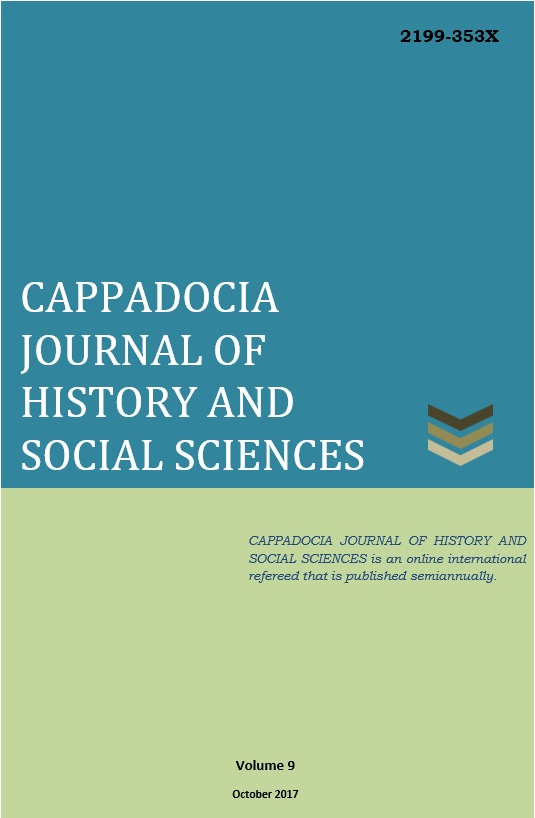MERKEZİ BEREKETLİ HİLAL BÖLGESİ’NDE SERAMİK ÖNCESİ NEOLİTİK DÖNEM ÖLÜ GÖMME GELENEKLERİ IŞIĞINDA DÖNEMİN SOSYAL YAPISI HAKKINDA BİR DEĞERLENDİRME
Author :
Abstract
Ölü gömme gelenekleri, toplulukları oluşturan bireylerin topluluk yapısı içerisindeki sosyal statülerinin anlaşılması noktasında önemli bilgiler sağlamaktadırlar. Farklı bireyler üzerinde saptanan farklı uygulamaların yanı sıra mezarlarda tespit edilen ölü hediyeleri, topluluğun sosyal yapısı içerisindeki tabakalaşmayı gösterir niteliktedirler. Bu çalışma içerisinde Merkezi Bereketli Hilal Bölgesi kapsamındaki, Türkiye’nin Güneydoğu Anadolu Bölgesi, Kuzey Suriye ve Kuzey Irak’ta bulunan Seramik Öncesi Neolitik Dönem yerleşimleri ölü gömme gelenekleri noktasında sosyal yapı açısından değerlendirilecektir.
Keywords
Abstract
Abstract Burial traditions provide significant information on the social status of the community members in the group’s social structure. Different burial practices on different group members and burial gifts both signify the existence of a stratigraphy in the group’s social structure. In this study, Central Fertile Cresent Pre-Pottery Neolithic Settlements which are located in Southeastern Turkey, Northern Syria and Northern Iraq are evaluated in terms of social structure by means of the burial traditions.
Keywords
- Atakuman, Ç. (2014 a). Neolitik Süreci Yeniden Tanımlamak: Güneydoğu Anadolu Neolitiğinde Mekan Kurgusu ve Sosyal İlişkiler. Yerleşim Sistemleri ve Mekan Analizi TAS (1), 191216.
- Bryce, T. (2009). The Routledge Handbook of The Peoples and Places of Ancient Western Asia. The Near East from the Early Bronze Age to the Persian Empire. London, New York: Routledge.
- Coqueugniot, E. (1998). Dja’de el Mughara (moyen-euphrate), un village neolithique dans son environnment naturel a la vielle de la domestication. Geyer Bernard (Editör). Lyon: Maison de l'Orient et de la Méditerranée Jean Pouilloux, pp. 1-8.
- Erdal, Y. S. (2015). “Bone or Flesh: Defleshing and Post-Depositional Treatments at Körtik Tepe (Southeastern Anatolia, PPNA Period)”. European Journal of Archaeology,18(1), 4-32.
- Erim-Özdoğan, A. (2002). Çayönü Tepesi. Arkeoatlas 1, 77.
- Erim-Özdoğan, A. (2007). Çayönü. M. Özdoğan, N. Başgelen (Editörler) Anadolu’da Uygarlığın Doğuşu ve Avrupa’ya Yayılımı Türkiye’ de Neolitik Dönem. Yeni Kazılar, Yeni Bulgular. İstanbul: Arkeolji ve Sanat Yayınları, s. 57-97.
- Erim-Özdoğan, A. (2012). Çayönü. Aktüel Arkeoloji, 27, 108-117.
- Hauptmann, H. (1999). The Urfa Region. Neolithic in Turkey, M. Özdoğan ve N. Başgelen, (Eds.) İstanbul: Arkeoloji ve Sanat Yayınları, pp. 65-86.
- Hauptmann, H. (2007). Nevali Çori ve Urfa Bölgesinde Neolitik Dönem. M. Özdoğan, N. Başgelen (Editörler). Anadolu’da Uygarlığın Doğuşu ve Avrupa’ya Yayılımı Türkiye’ de Neolitik Dönem. Yeni Kazılar, Yeni Bulgular. İstanbul: Arkeolji ve Sanat Yayınları, s. 131-164.
- Hole, F. (2000). Is size important? Function and Hierarchy in Neolithic Settlements. Ian Kujit (Ed.). Life in Neolithic Farming Communities: Social Organization, Identitiy and Differantiation. New York: Kluwer Academic/Plenum Publishers, pp.191-209.
- Karul, N. (2013). Gusir Höyük/ Siirt, Yerleşik Avcılar. Arkeo-Atlas Bereketli Hilal Dicle’nin Kurtarma Kazıları, 22-29.
- Kozlowski, S. F. (1989). Nemrik 9, a PPN Neolithic site in Northern Iraq. Paléorient, 15(1), 25-31.
- Kuijt, I., Guerrero, E., Molist, M., Anfruns,J. (2011). The Changing Neolithic Household: Household Autonomy and Social Segmentation, Tell Halula, Syria. Journal of Anthropological Archaeology, 30, 502-522.
- Miyake, Y. (2013). Hasankeyf Höyük/ Batman, Dicle’nin İlk Köyü. Arkeo-Atlas Bereketli Hilal Dicle’nin Kurtarma Kazıları, 40-47.
- Moore, A. M. T. (1998). The interaction between people and environment at the early village of Abu Hureya on the Euphrates In Lyon: Maison de l'Orient et de la Méditerranée Jean Pouilloux, pp.131-138.
- Moore, A.M.T., Hillman, G.C., Legge, A. J. (2000). Village on the Euphrates from foraging to farming at Abu Hureya. Oxford: Oxford University Press.
- Olszewski, D. (1986). The North Syrian Late Epipaleolithic. The earliest occupation at Tell Abu Hureya in the context of the Levantine Late Epipaleolithic. Oxford: BAR International Series
- Özbek, M. (2004). Çayönü’nde İnsan. İstanbul: Arkeoloji ve Sanat Yayınları.
- Özbek, M. (2009). Köşk Höyük (Niğde) Neolitik Köyünde Kil Sıvalı İnsan Başları. Hacettepe Üniversitesi Edebiyat Fakültesi Dergisi 26/1, 145-162
- Özdoğan, A. (1999). Çayönü. M. Özdoğan, N. Başgelen, (Eds). Neolithic in Turkey: The Cradle of Civilization. İstanbul: Arkeoloji ve Sanat Yayınları, pp. 35-64.
- Özkaya, V.. Çoşkun A. (2009). Excavations at Körtik Tepe. A New Pre-Pottery Neolithic A Site in Southeastern Anatolia. Neo-Lithics, (2009/2), 1-8.
- Rosenberg M. (2007). Hallan Çemi. Mehmet Özdoğan ve Nezih Başgelen, (Editörler). Anadolu’da Uygarlığın Doğuşu ve Avrupa’ya Yayılımı Türkiye’de Neolitik Dönem Yeni Kazılar, Yeni Bulgular. İstanbul: Arkeoloji ve Sanat Yayınları, s. 1-11.
- Rosenberg, M. ve Redding, R. W. (2000). Hallan Çemi and Early Village Organization in Eastern Anatolia. Kuijt I. (Ed.). Life in Neolithic Farming Communities. Social Organization, Identity, and Differentiation. New York: Kluwer Academic Publishers, pp. 39-61.
- Schmidt, K. (2007 a). Göbekli Tepe. M. Özdoğan ve N. Başgelen, (Editörler). Anadolu’da Uygarlığın Doğuşu ve Avrupa’ya Yayılımı Türkiye’de Neolitik Dönem Yeni Kazılar, Yeni Bulgular. İstanbul: Arkeoloji ve Sanat Yayınları, s. 115-129.
- Schmidt, K. (2007 b). Göbekli Tepe- Taş Çağı Avcılarının Gizemli Kutsal Alanı. İstanbul: Arkeoloji ve Sanat Yayınları.
- Schmidt, K. (2011). Göbekli Tepe. M. Özdoğan, N. Başgelen, P. Kuniholm. (Eds). The Neolithic in Turkey. New Excavations, New Research Vol. 1 İstanbul: Arkeoloji ve Sanat Yayınları, pp.41-83.
- Simmons, A. H. (2007). The Neolithic Revolution in the Near East. Tucson: The University of Arizona Press.
- Starkovich, B. M., Stiner, M. C. (2009). Hallan Çemi Tepesi: High-ranked Game Exploitation alongside Intensive Seed Processing at the Epipaleolithic-Neolithic Transition in Southeastern Turkey. Anthropozoologica, 44(1), 41-61.
- Willcox, G. (2002). Charred plant remains a 10th millenium B.P. kitchen at Jerf el-Ahmar (Syria). Veget Hist Archaeobot, 11, 55–60.
- Yılmaz, Y. (2010). Neolitik Dönemde Anadolu’ da Ölü Gömme Uygulamaları: Çayönü Örneği. İstanbul Üniversitesi, Doktora Tezi.
